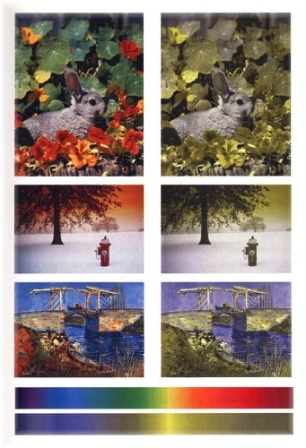In contrast to other dogs, my dogs are not very interested in watching TV. However, with the development of new technologies this might change in the future.
According to Ernst Otto Ropstad, an associate professor at the Norwegian School of Veterinary Science, with the development of newer TV’s with a higher resolution and more frames per second, dogs might be able to actually perceive TV as film instead of a set of flickering images.
Where we as humans need about 16 to 20 frames per second to perceive images as moving film, according to this article, dogs need about 70 frames per second. Still, dogs perceive the content in a different way than humans, because dogs see different colours. They perceive colours with only two cones (retina receptors) where humans have three. In his book, The Truth About Dogs, Steven Budiansky shows the image below, visualising how dogs perceive colours based on a research by Neitz, Geist, and Jacobs. The left size represents the image how humans would observe it and the right side shows the perception of dogs. Due to this difference in visual capabilities, dogs also generally see less detail than humans.
According to Ropstad, not all dogs can see equally well or show as much interest in watching TV as others. There might be a difference in dog breeds and/or an individual difference that has not been researched yet.
The activity of TV watching dogs has already been recognized by Dog TV channel startups that create content specifically for dogs. Besides some ear movements, my dogs were not too enthusiastic about the videos shown for example on the website of DOGTV, but perhaps a better frame rate, bigger screens, and less lazy dogs might give more interesting results.

